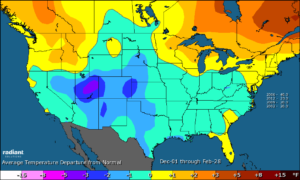Weather Fundamentals: What is an Analog Winter Forecast?
2 min readEvery month, Constellation hosts the Energy Market Intel Webinar where attendees learn about the energy market trends that may affect future contracting decisions, such as weather, gas storage and production updates. Attendees of the Market Intel webinars have an opportunity to ask questions related to energy market trends during webinars. In the November Market Intel webinar, a viewer asked the following:
What is meant by an analog winter forecast?
When meteorologists assemble a long-term weather forecast, such as a winter or summer forecast, they will examine current atmospheric conditions and look for previous years with similar conditions. This is considered an analog winter forecast.
Below is the December-February temperature departure map of our four-analog (similar) years averaged together. The four analog years that were used were 2002, 2006, 2009 and 2012. The global weather patterns that are analyzed include but are not limited to El Niño/La Niña; the Pacific Decadal Oscillation (i.e., measurement of north Pacific water temperatures); the Atlantic Multi-Decadal Oscillation (i.e., measurement of Atlantic water temperatures); and the Ouasi-Biennial Oscillation (i.e., measurement of wind direction at the top of the atmosphere). Some of these patterns carry a bit more weight than others, which is determined by our experience and research. We take these years with the most similar global weather pattern, then map the temperature outcome for the United States.

Source: EarthStat
The map above represents a compilation of the four years listed above to come up with an aggregate impact that reflects what the Constellation Meteorology team sees as key temperature patterns across the United States this winter from a December through February time frame. The Southwest and Great Plains states will see the most significant below normal temperatures. It is important to note that this is a three-month forecast and that individual months could vary significantly.
To hear the latest on the 2018/2019 winter forecast, sign up for Constellation’s December 19th Energy Market Intel webinar.
